Art Criticism
The Brooklyn Museum’s Much-Criticized ‘It’s Pablo-matic’ Show Is Actually Weirdly at War With Itself Over Hannah Gadsby’s Art History
"It's Hannah-matic," Part 1 of a 2-part series on "It's Pablo-matic" at the Brooklyn Museum.
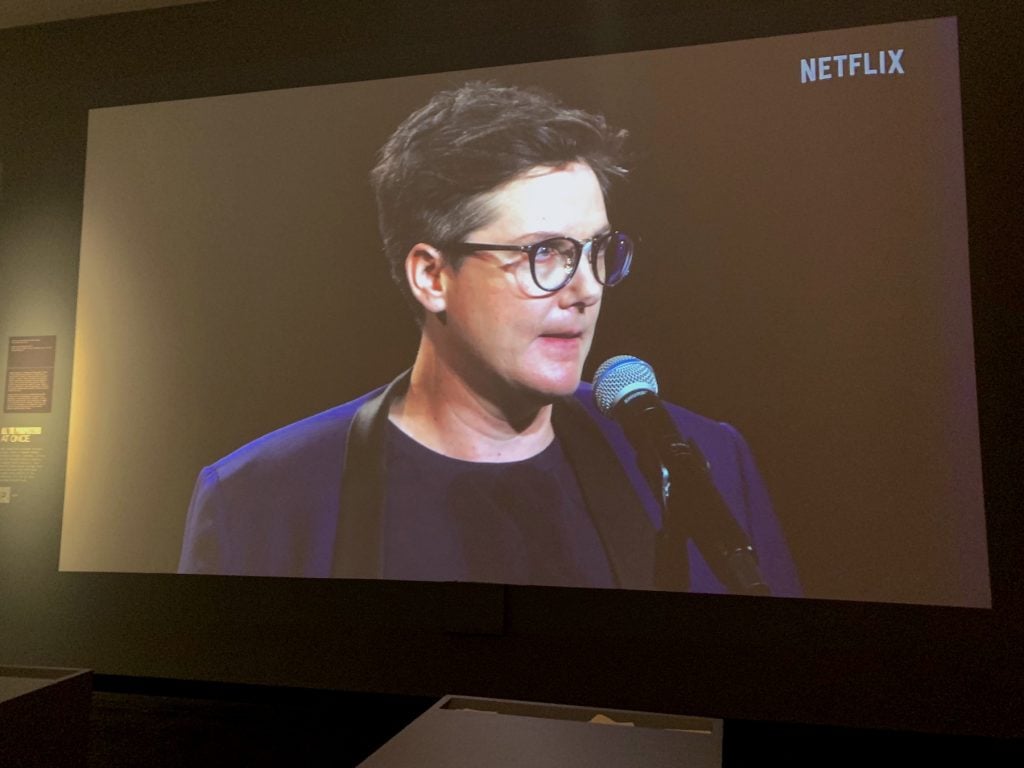
"It's Hannah-matic," Part 1 of a 2-part series on "It's Pablo-matic" at the Brooklyn Museum.

Ben Davis

Hannah Gadsby’s 2018 alt-comedy special for Netflix, Nanette, was critically beloved with an intensity that was rare for stand-up. The Australian comedian’s hybrid of observational comedy, confessional narrative, and revisionist art history was a genuine event, within “the discourse,” at least. Nanette even won a Peabody Award, with the committee celebrating it as a “blistering, indicting, powerful treatise,” and comparing Gadsby to Aristotle and Freud.
By contrast, I’ve never seen more critical backlash in advance than there has been for “It’s Pablo-matic,” the attempt to translate Gadsby’s takedown of Pablo Picasso from Nanette into the form of an art show at the Brooklyn Museum, co-curated by Gadsby with Catherine Morris and Lisa Small. For months, every time I logged onto Twitter, someone from a different corner of the art commentary world would be snarking about it.
And now, “It’s Pablo-matic” is here. The reviews are in. They are just as bad as you might have predicted.
The disparity in reactions to Nanette versus reactions to “It’s Pablo-matic” might represent different things. It might suggest a change in the surrounding political and cultural moment—a “vibe shift,” if you will. Or it might stem from a change in where the takes are coming from, as we go from the general-interest audience of Netflix to the more specific audience of art—suddenly critics who always had doubts about Gadsby’s art history have their moment to speak. Or it might just be that the Brooklyn Museum bungles the show.
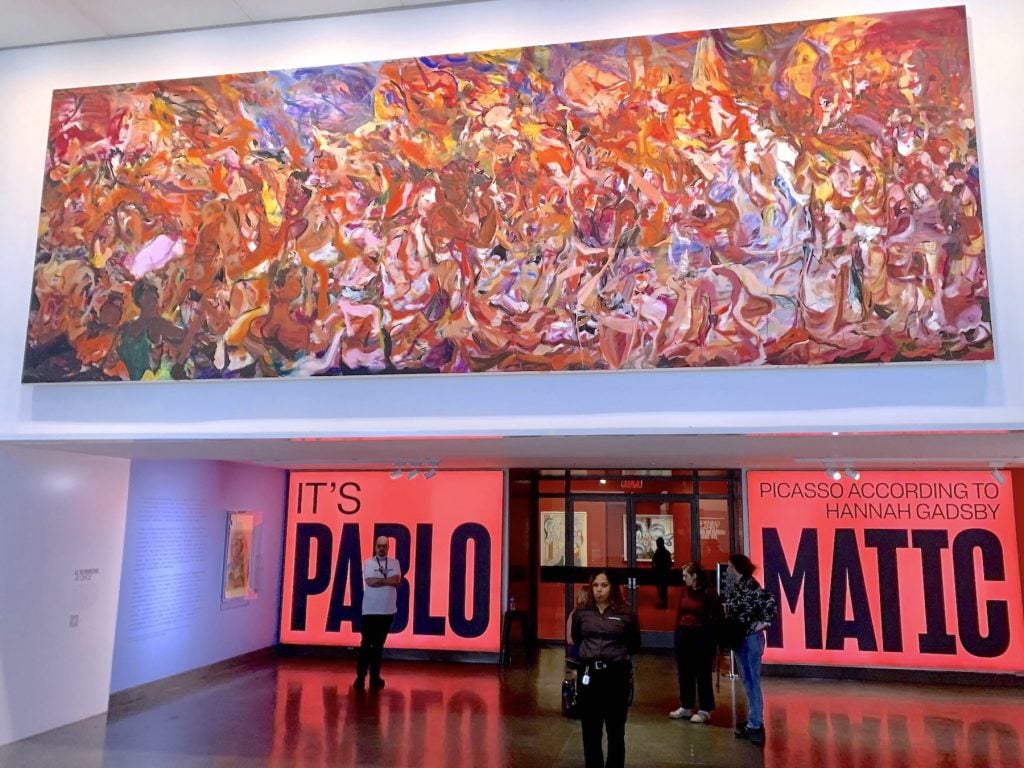
Entrance to “It’s Pablo-matic” at the Brooklyn Museum, with Cecily Brown, Triumph of the Vanities II (2018). Photo by Ben Davis.
In fact, I think it represents all three of these things. But they’re important to tease apart.
On the last of the three counts, “It’s Pablo-matic” is probably the most oddly conceived major museum show since the great MoMA “Bjork” disaster of 2015. It is a different kind of disaster but for the exact same reason: a too-worshipful approach to contemporary celebrity.
“Bjork” can be seen as the self-immolating climax of the hare-brained early-2010s celebrity-art-media fusion—the time when a pre-#MeToo James Franco was showing his video art at the Clocktower, and Jay-Z was summoning celebs and artists together to Pace gallery to rap about his art collection (“I just want a Picasso, in my casa”—not his best work).
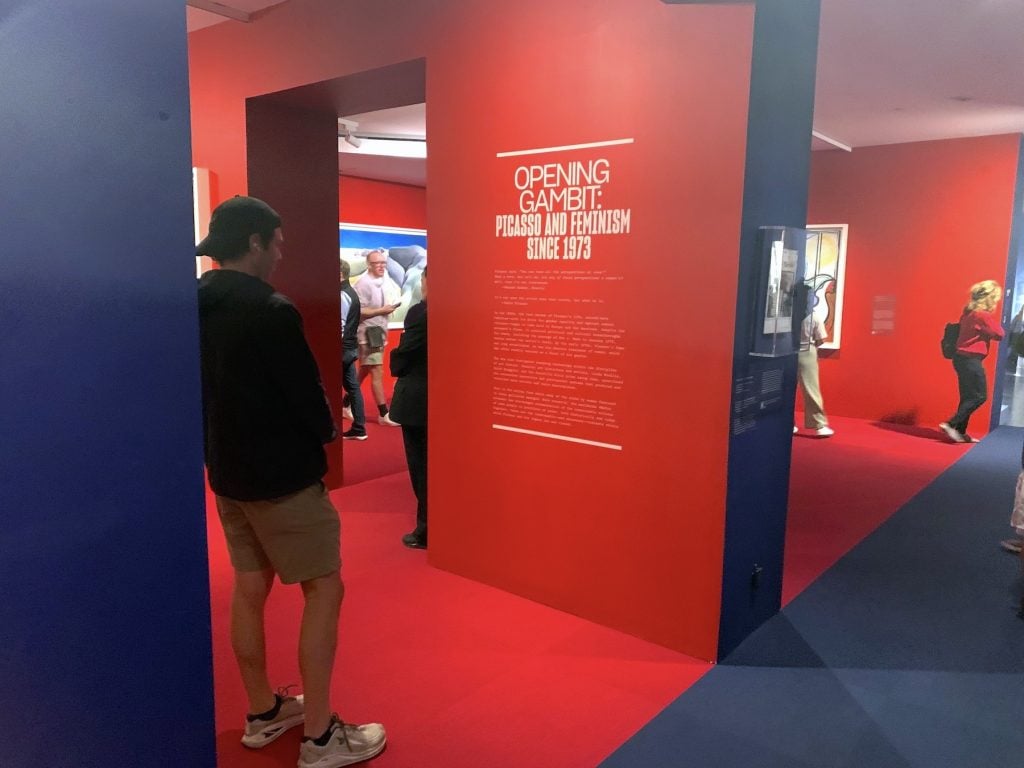
The opening gallery of “It’s Pablo-matic.” Photo by Ben Davis.
The “Bjork” show itself was bad—but I said at the time that it also served as an excuse to vent all the irritation that had been building about the superficial money-and-celebs vibe of the preceding years. “It’s Pablo-matic” is clearly filling the same function for the more recent era of superficial hyper-moralism in art— “a time when nuance and all the confused intentions, desires, and beliefs that go along with it are considered less a way of understanding human frailty than a failure of ‘accountability,'” as Hilton Als already put it in a sharply critical essay about Douglas, Gadsby’s follow-up to Nanette.
“It’s Pablo-matic” is two things, awkwardly fused. A little less than half of it consists of low-tier Picasso works, mainly etchings, timed to the 50th anniversary of his death. These are accompanied by wall texts giving us a Hannah Gadsby quip mocking each one, presented as extending Nanette’s project of cutting Picasso’s “genius” status down to size.

Dara Birnbaum, Technology/Transformation: Wonder Woman (1978-79) and Harmony Hammond, Hunkertime (1980) in “It’s Pablo-matic.” Photo by Ben Davis.
The other part of the show—a little more than half of the works numerically, but much more than half in terms of how this show feels, because the Picasso works are mostly small—is something else entirely: a selection of art by an eclectic array of artists with feminist credentials. These artworks don’t really seem to have anything to do with Picasso, not directly.
What does Hannah Gadsby bring to the table here? Let me give you an example of the level of wit in “It’s Pablo-matic.” Alongside the classicizing etching of Nude Women before a Statue (1939), Gadsby’s label comments sarcastically, “It must have been very hot in Paris in the ‘30s.” Because she is not wearing clothes.
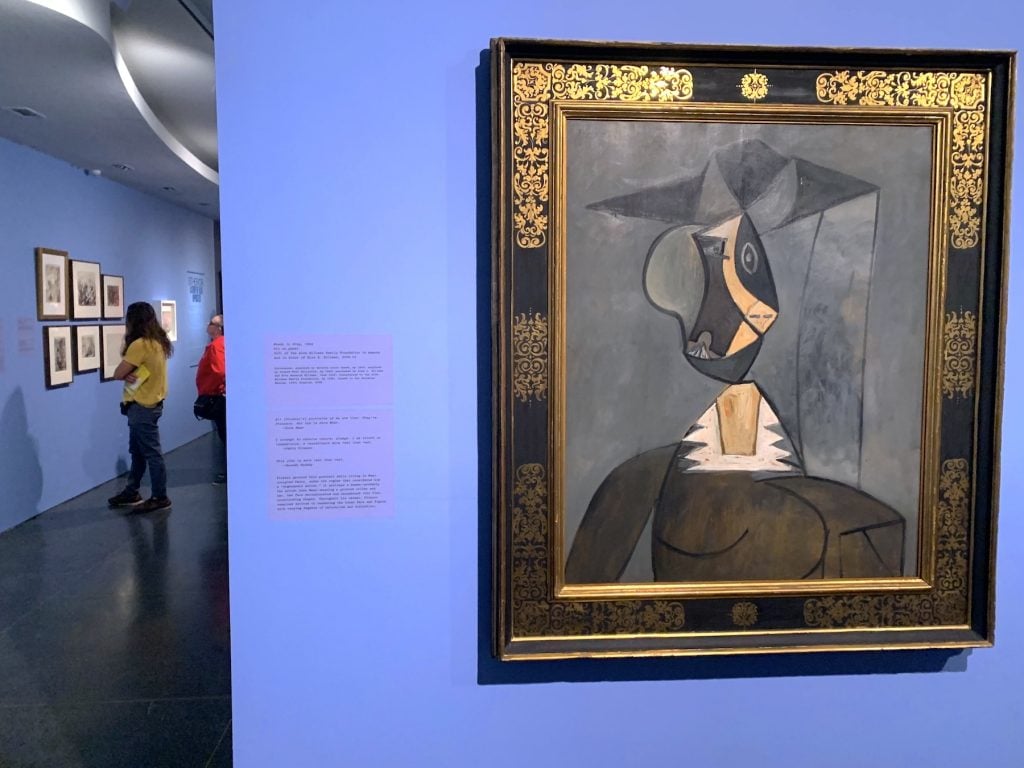
Pablo Picasso, Woman in Gray (1942) in “It’s Pablo-matic.” Photo by Ben Davis.
Beside a Cubistic picture of Dora Maar called Woman in Gray, about which Picasso said he tried to capture “a resemblance more real than real,” the best Gadsby can do is, “This joke is more real than real.” As commentary or as comedy, this feels… low effort.
It’s not just that I think the “neener-neener-you’re-a-weiner” style of commentary in “It’s Pablo-matic” is lazy. Often Gadsby’s jokes, rather than adding to what you see, play up a “modern art is a fraud” tone that you’d think would be beneath the Brooklyn Museum. Beside a tiny, rough plaster sculpture of an expressionist head, “This is one of those pieces that you only need to glance at to understand why so many people point out that Picasso had no formal training in sculpture. It is hard to be impressed otherwise.”
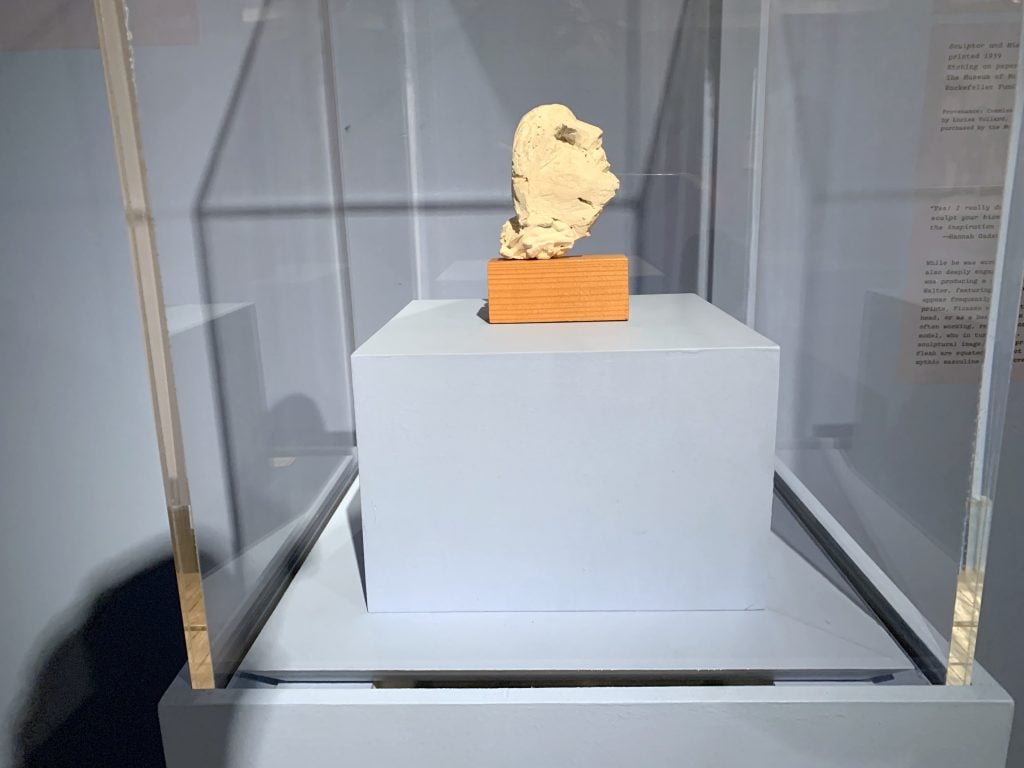
Pablo Picasso, The Crying Woman (1937). Photo by Ben Davis.
This is particularly intellectually dishonest because a lot of the works in the show aren’t particularly great Picassos, but the show lets Gadsby hold them up to say “this guy is not so great!”
Maybe we need to go back and ask what was actually distinctive about Nanette’s take on art history and Picasso in the first place.
Has there been a Picasso Cult that has sold his art on fables of his virility and ignored any suggestion of the dark side of his personal life? Yes! Back in 1964, when his former lover, the painter Françoise Gilot, published her book Life With Picasso—the source of many of the anecdotes advanced to criticize him now—dozens of French intellectuals signed a statement demanding it be suppressed.
But feminist art history has been around since before Gadsby or I were born, and majorly influential for decades. At this point, the charge that Picasso could be a tyrant to those around him—philandering, chauvinist, controlling, manipulative, abusive—is not even truly novel at the pop culture level. Arianna Huffington’s Picasso: Creator and Destroyer was published in 1988. (Read novelist Fernanda Eberstadt’s review of the controversy around that work and you will feel like you are in a time loop.)
A comedy special about art history is novel, but as art history, what was novel about Nanette was Gadsby’s suggestion that, post-#MeToo, Picasso’s art couldn’t be enjoyed: “Picasso said, ‘You can have all the perspectives at once—from above, from below. All the perspectives at once!’ What a hero. But tell me, are any of those perspectives a woman’s? Well, then, I’m not interested.” (The term “cancel culture” actually exploded just one week after Nanette debuted, via a Times article about Kanye West.)
“It’s Pablo-matic” tries to adapt the spirit of Gadsby’s argument into an exhibition. But I have to say, after spending four hours in it, I started to suspect that what makes the show so strange and strained is that it is actually trying to work against Nanette’s arguments—but without ever admitting that this is what is happening.
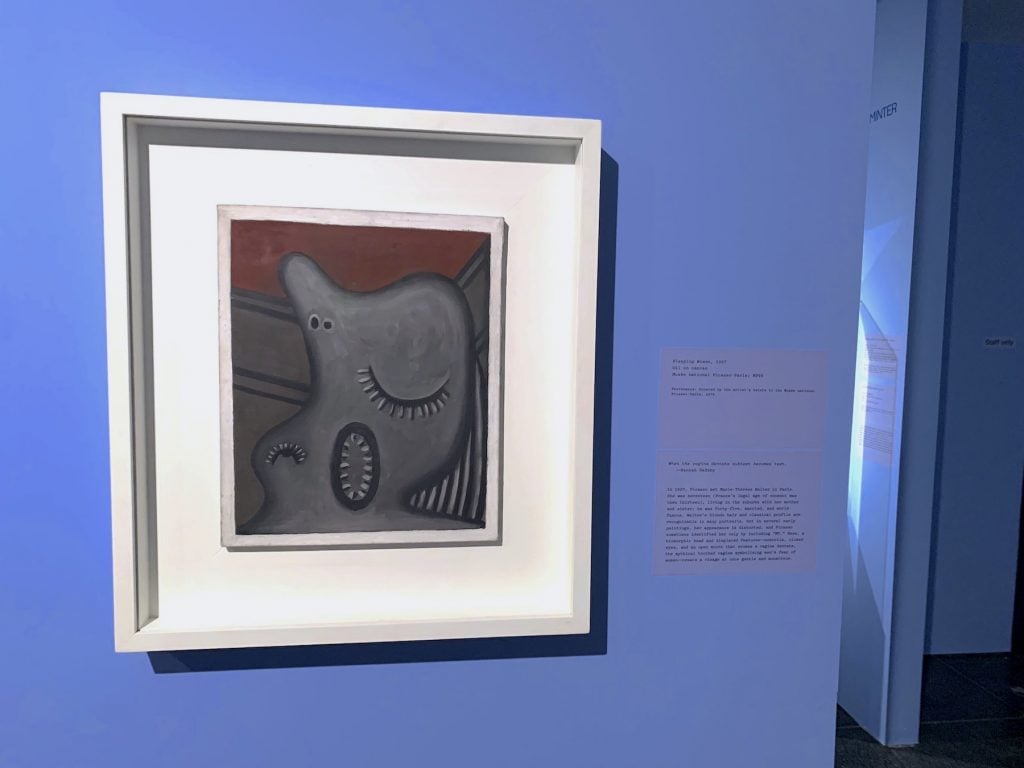
Pablo Picasso, Sleeping Woman (1927). Photo by Ben Davis.
This extends as far as a ginger curatorial disagreement about the agency of Picasso’s lovers. “Picasso fucked an underage girl,” Gadsby says, in the 13-minute excerpt from Nanette that plays on a screen between galleries at the Brooklyn Museum. “That’s it for me, not interested. But Cubism! He made it! Marie-Thérèse Walter, she was 17 when they met: underage. Picasso, he was 42, at the height of his career. Does it matter? It actually does matter.”
Wall texts one gallery over remind viewers that legal age of consent in France at the time was 13, and quote Walter remembering the experience positively: “We would joke and laugh together all day, so happy with our secret, living a totally non-bourgeois life… you know what it is to be really in love? Well, who needs anything else then? We spent our time worrying about nothing, doing what every couple does when they’re in love.”
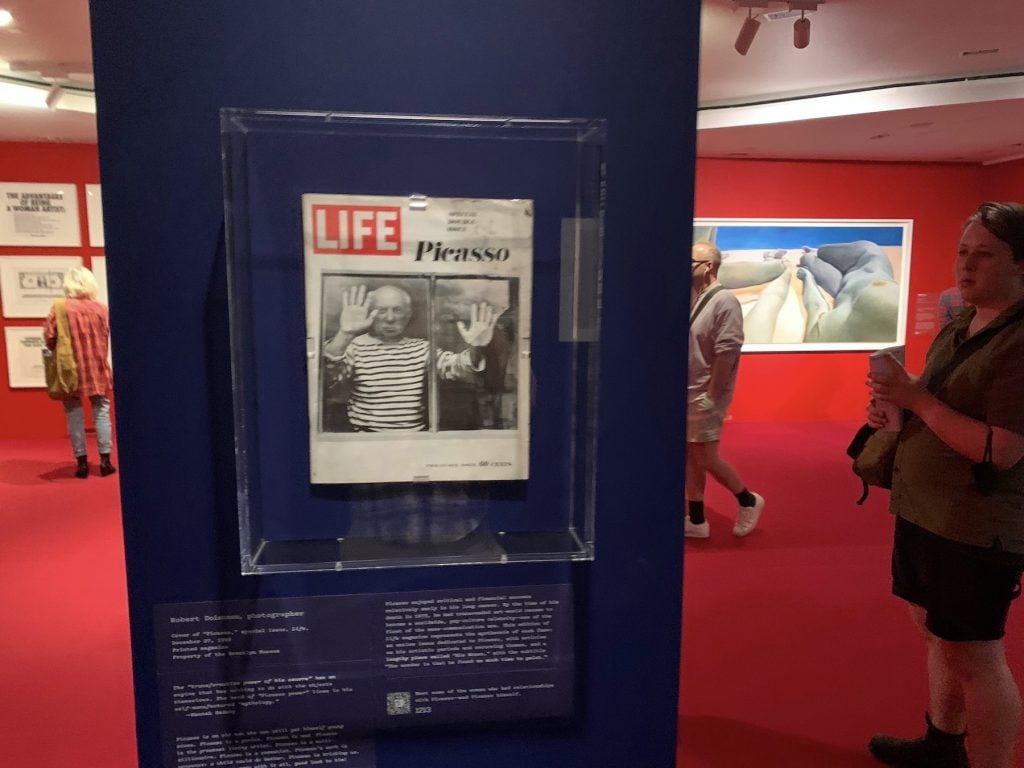
A 1968 issue of Life magazine featuring Pablo Picasso on view in “It’s Pablo-matic.” Photo by Ben Davis.
Without saying the relationship was OK by today’s standards, the curators seem to be gently conceding that, while the worship of Picasso might keep us from understanding the women in his life, the denunciation of Picasso might also be doing the same. (The Brooklyn Museum may feel like it has to address the age issue in particular because Gadsby has been criticized for ignoring the facts. But perhaps it is also nervously remembering that David Bowie, the subject of his own Brooklyn Museum blockbuster, has been semi-“cancelled” over something similar.)
In the looped clips of Nanette that play in the galleries, guests will hear Gadsby suggest that only an apologist for patriarchy could value Picasso’s art: “He’s sold to us as this passionate, virile, tormented-genius man-ballsack, right?” Less colorfully, but more clearly, you also read Gadsby say this in the galleries: “The ‘transformative power of his oeuvre’ has an engine that has nothing to do with the objects themselves. The seed of ‘Picasso power’ lives in his self-manufactured ‘mythology.'”
But go actually read Gilot’s Life With Picasso for a counterpoint. I did for this review. It has a weird effect, sharpening and nuancing my understanding of his dark side, but also expanding my appreciation of Picasso as a visual thinker. (On its own, Gilot’s recollection of Picasso carefully explaining his theories in Chapter 12 is one of the most illuminating things I have ever read about his art.)
Gilot writes the following at one point: “It wasn’t that I didn’t admire his greatness; it was, rather, that I didn’t enjoy seeing it cheapened by a kind of imperialism which I thought incompatible with true greatness.” That seems a fine approach: You can appreciate a lot about the art without worshiping the “tormented-genius man-ballsack” stuff.
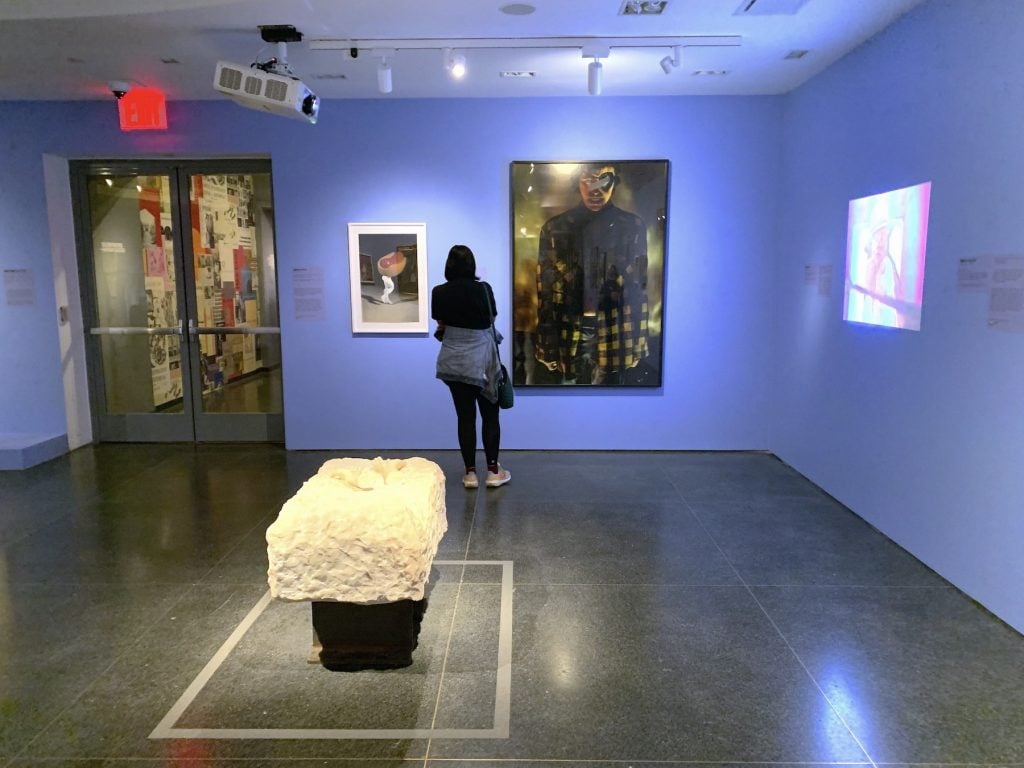
A gallery in “It’s Pablo-matic.” Photo by Ben Davis.
The non-Picasso works in “It’s Pablo-matic,” shown in galleries with names like “(Powerful) Women Doing (Powerful) Stuff,” feel random. But to justify them, an effort has been made to get each of these artists’ takes on Picasso. Their quotes on him are spotlighted in the labels.
And here, again, you definitely feel the show pulling away from the comedian at the center of it.
Gadsby’s uncompromising argument about Picasso’s art—”I fucking hate him…. He’s a rotten-in-the-face cavity… You can’t make me like [him]”—is most closely echoed by Judy Chicago. She says that separating the art from the artist is “patriarchal nonsense,” expressing disgust about Picasso’s treatment of women, and concluding, “I don’t particularly admire either Picasso or his work.”
But many more of the artists in “It’s Pablo-matic” basically sound off against Gadsby’s argument, in diverse ways. Gadsby declares sarcastically in Nanette: “Aren’t we grateful, in this room, that we live in a post-cubism world?” But when you actually steep in this show, you will find that its artists are more often than not replying, “Well, actually…”
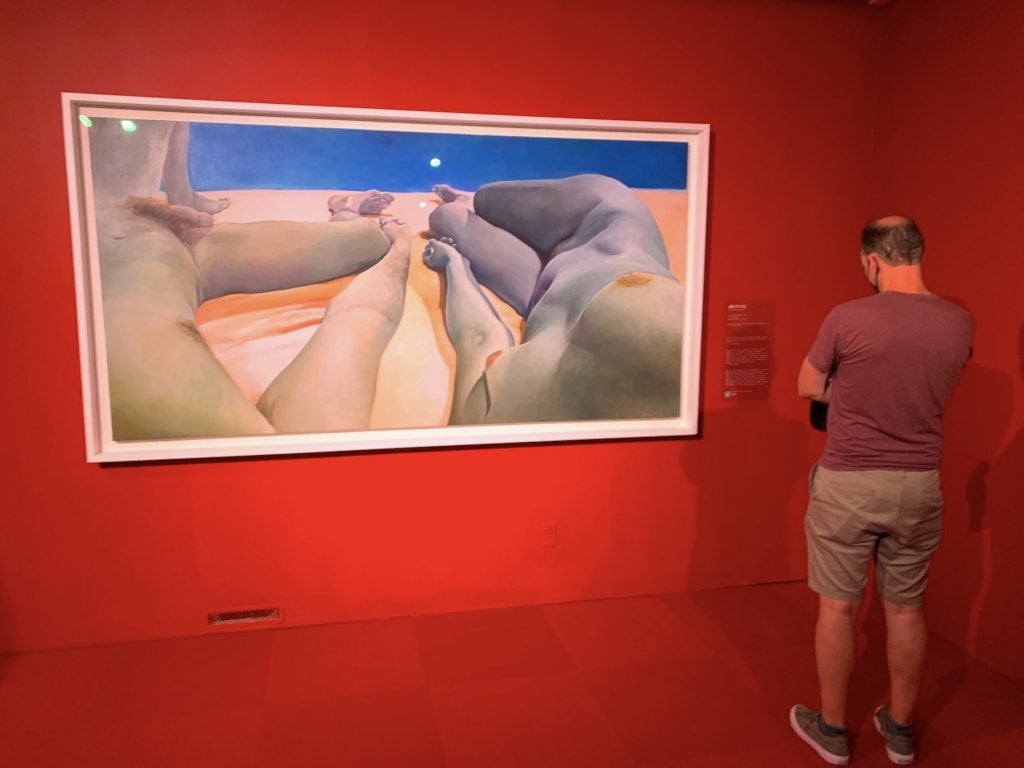
Joan Semmel, Intimacy-Autonomy (1974) in “It’s Pablo-matic.” Photo by Ben Davis.
Cecily Brown: “[Picasso] invents and invents and invents. And you always feel with him that he’s making a new way to say ‘a hand,’ for example, every single time.”
Joan Semmel: “I have always loved his work and marveled at the ground it has broken, opening new doors into seeing. Engaging with the work can lead one to want to know the artist, but I prefer to not conflate the personality and the art.”
Cindy Sherman: “I have conflicting/ambivalent feelings about Picasso; I would say I begrudgingly admire his artistic genius. But I think I’ve always felt that, I do think it’s possible, maybe necessary, to separate art from the artist.”
Mickalene Thomas: “Picasso is not an unfamiliar reference for me and I have been contending with his oeuvre through my own work for several years.”
Marilyn Minter: “Without a doubt, he was a great artist, despite being a horrible human being. I have to think about [the art and the artist] separately, otherwise I wouldn’t be able to learn anything.”
Kiki Smith: “I was once asked by an auction house to give a talk about Picasso’s prints. They wanted me to speak critically of him as a person, but upon seeing the prints, I was deeply humbled. His work has often been a guide for me.”
And then there’s Louise Bourgeois, grande dame of psycho-sexual sculpture, summoned from beyond the grave by the curators of “It’s Pablo-matic” to remember her reaction to a big Picasso retrospective at MoMA in 1939: “It was so beautiful, and it revealed such genius and such a collection of treasures that I did not pick up a paintbrush for a month.”
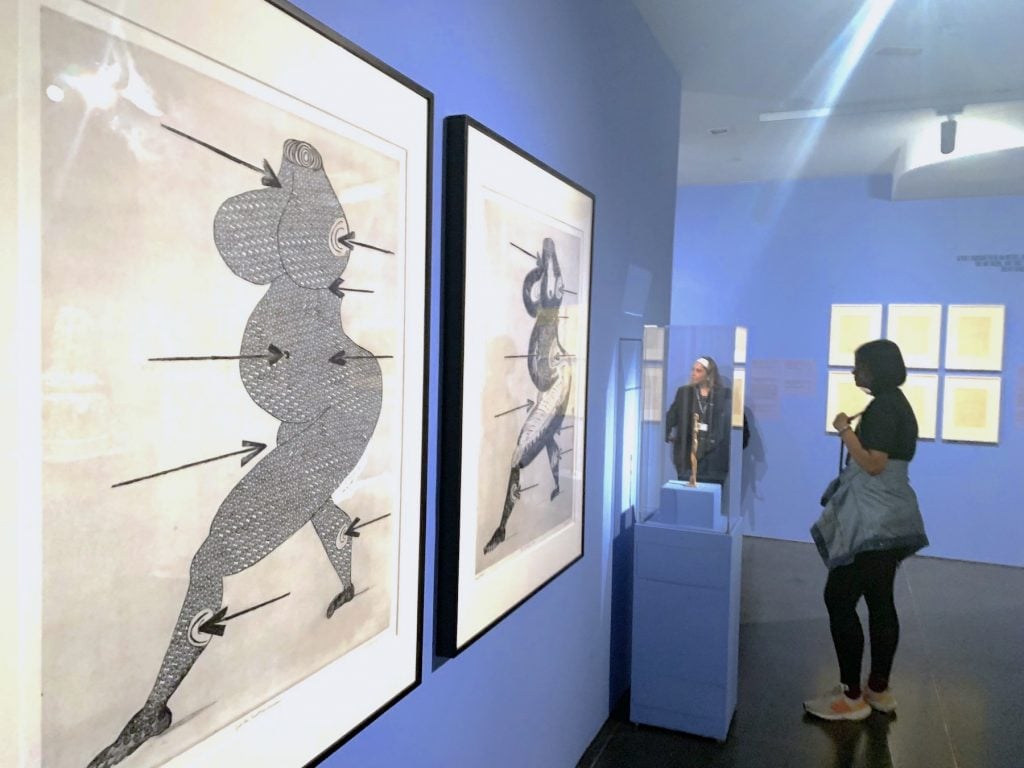
Louise Bourgeois, Tapestry (1994) and Tapestry (1995). Photo by Ben Davis.
The curators could also have quoted Bourgeois’s notes to herself in her diary, where she spoke of what made Picasso’s work transformative for her in a way that the Surrealists were not: “Picasso paints what is true; true movements, true feelings… Skepticism is the beginning of decadence. It’s a form of abdication and bankruptcy.”
It occurs to me that, if the selection of artists complementing Picasso in “It’s Pablo-matic” at first seems to have little to do with Picasso, the chorus of voices in the labels ends up suggesting a possible thesis: “We have to understand that Picasso has been an inspiration—even where you wouldn’t expect it.”
At any rate, you can definitely say that had Louise Bourgeois applied Hannah Gadsby’s “not interested!” perspective, we might not have gotten the artist whose gut-punch work we find so resonant now. The posture of looking at the art mainly as a referendum on the artist has a real cost—and not just for the patriarchy.
And this strange disagreement between curator and the artists in the show is not even the strangest thing about “It’s Pablo-matic.” I’ll get into that next time.
To read Part 2 of “It’s Hannah-matic,” click here.